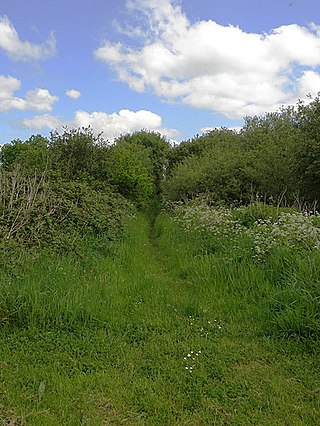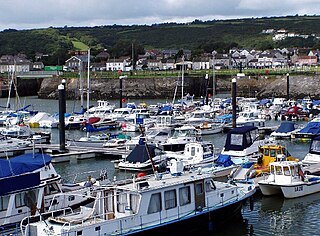
Burry Port is a port town and community in Carmarthenshire, Wales, on the Loughor estuary, to the west of Llanelli and south-east of Kidwelly. Its population was recorded at 5,680 in the 2001 census and 6,156 in the 2011 census, and estimated at 5,998 in 2019. The town has a harbour. It is also where Amelia Earhart landed as the first woman to fly across the Atlantic Ocean. Nearby are the Pembrey Burrows sand dune and wetland system, forming a country park, and the Cefn Sidan sands. Its musical heritage includes Burry Port Opera, Male Choir and Burry Port Town Band.
The Burry Port and Gwendraeth Valley Railway (BP&GVR) was a mineral railway company that constructed a railway line in Carmarthenshire, Wales, by conversion of a canal, to connect collieries and limestone pits to the sea at Kidwelly. It extended its network to include Burry Port, Trimsaran and a brickworks at Pwll, later extending to Sandy near Llanelli. For a time the company worked the separate Gwendraeth Valleys Railway. The BP&GVR was notable because of the very low height of some overbridges, a legacy of the canal conversion.

Kidwelly railway station serves the town of Kidwelly, Carmarthenshire, Wales. The station is situated on the coast just southwest of Kidwelly itself. It is 234 miles 32 chains (377.2 km) from the zero point at London Paddington, measured via Stroud.
The Carmarthen and Cardigan Railway was a 7 ft 1⁄4 in broad gauge railway line in Wales that was intended to connect Carmarthen on the South Wales Railway with Cardigan. In fact, it was unable to raise the necessary capital and was loss-making from the time of opening the first short section of its line in 1860, and it was in receivership for much of its life. It eventually reached Llandysul in 1864 but was not extended further during its independent existence.
Trimsaran is a community and former mining village which lies on the B4308 between Llanelli and Kidwelly, in the Welsh county of Carmarthenshire.
Cefneithin is a village and community in Carmarthenshire, Wales, in the Carmarthenshire coalfield area. It lies just off the A48 road, 7 miles north west of Ammanford and 9 miles north of Llanelli. Its nearby community villages include Cross Hands, Drefach, Cwmmawr, Foelgastell and Gorslas. The Gwendraeth Fawr river flows nearby and its source is at Llyn Llech Owain, just north of the village. Cefneithin has a chapel (Tabernacl), a village hall, a primary school, and a secondary school. The latter, Ysgol Maes y Gwendraeth, was re-opened in 2016 after an extensive renovation and an £18.4m investment; it has 1,000 pupils, of which 157 in sixth form, and resources for children with additional learning needs. Prior to 2016 when the school was called Ysgol Gyfun Maes Yr Yrfa, some of its famous pupils include Nigel Owens, Jonathan Edwards, TV presenter Alex Jones and British and Irish Lion rugby player, Dwayne Peel.

The Kidwelly and Llanelly Canal was a canal and tramroad system in Carmarthenshire, Wales, built to carry anthracite coal to the coast for onward transportation by coastal ships. It began life as Kymer's Canal in 1766, which linked pits at Pwll y Llygod to a dock near Kidwelly. Access to the dock gradually became more difficult as the estuary silted up, and an extension to Llanelli was authorised in 1812. Progress was slow, and the new canal was linked to a harbour at Pembrey built by Thomas Gaunt in the 1820s, until the company's own harbour at Burry Port was completed in 1832. Tramways served a number of collieries to the east of Burry Port.
The Llanelly and Mynydd Mawr Railway was authorised in 1875. It made use of part of the long defunct Carmarthenshire Railway or Tramroad of 1801. The older line began running trains in 1803, and was a plateway of about 4 feet gauge, with horse traction, for the purpose of bringing minerals from the Mynydd Mawr to the sea for onward shipment at Llanelly Docks.

Kidwelly Flats Halt railway station served the Royal Ordnance Factory (ROF) and RAF Pembrey at Pembrey, Carmarthenshire, Wales between 1941 and 1957. It was on the West Wales Line.
Craiglon Bridge Halt railway station may have served the Craig-Lon Colliery and its workers near Pembrey, but this business was closed in the 1930s. It continued to serve the inhabitants of the Lando area between 1932 and 1953 and was one of several basic halts opened on the Burry Port and Gwendraeth Valley Railway in Carmarthenshire, Wales. A firing range was located nearby in WWII.

Pinged Halt railway station was opened in 1909 but was renamed Pinged railway station in 1922. It continued to serve the inhabitants of the Pinged area between 1909 and 1953 and was one of several basic halts opened on the Burry Port and Gwendraeth Valley Railway in Carmarthenshire, Wales.
Trimsaran Road railway station was opened in 1909 at Morfa It continued to serve the inhabitants of the Trimsaran area between 1909 and 1953 and was one of several basic halts opened on the Burry Port and Gwendraeth Valley Railway in Carmarthenshire, Wales. It lay some distance to the west of the village of Trimsaran.

Glyn Abbey railway station was opened in 1909 as Pontnewydd Halt It continued to serve the inhabitants of the Pont-newydd area and hinterland between 1909 and 1943; it was one of several basic halts opened on the Burry Port and Gwendraeth Valley Railway in Carmarthenshire, Wales.

Pontyates railway station was opened in 1909 It continued to serve the inhabitants of the Pontyates / Pont-iets area and hinterland between 1909 and 1953; it was one of several stations opened on the Burry Port and Gwendraeth Valley Railway in Carmarthenshire, Wales.
Ponthenry railway station was opened in 1909 It continued to serve the inhabitants of the Pont-henri area and hinterland between 1909 and 1953; it was one of several basic stations opened on the Burry Port and Gwendraeth Valley Railway in Carmarthenshire, Wales.

Pontyberem railway station was opened in 1909 to timetabled passenger services however services for miners began in 1898. It continued to serve the inhabitants of the Pontyberem area and hinterland between 1909 and 1953; it was one of several basic stations opened on the Burry Port and Gwendraeth Valley Railway in Carmarthenshire, Wales.
Cwmmawr for Tumble railway station,Cwm Mawr railway station or Cwmmawr railway station was opened in 1913 to timetabled passenger services. It continued to serve the inhabitants of the Cwmmawr area and hinterland between 1913 and 1953; it was one of several basic stations opened on the Burry Port and Gwendraeth Valley Railway in Carmarthenshire, Wales.
Pembrey railway station or Pembrey Halt railway station served the village of Pen-bre or Pembrey. It continued to serve the inhabitants of the area between 1909 and 1953 and was one of several basic halts opened on the Burry Port and Gwendraeth Valley Railway in Carmarthenshire, Wales.
Burry Port railway station served the town of Burry Port. It continued to serve the inhabitants of the area near Llanelli between 1909 and 1953 and was one of several basic halts opened on the Burry Port and Gwendraeth Valley Railway in Carmarthenshire, Wales.

Burry Port Harbour is a former industrial harbour which mainly served the coal industry, on the Loughor estuary. It is now converted into a marina. The town of Burry Port grew around the harbour.









